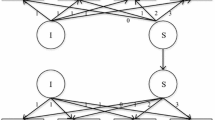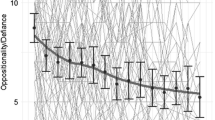Abstract
Among the available treatments for disruptive behavior problems, a need remains for additional service options to reduce antisocial behavior and prevent further development along delinquent and violent pathways. The Stop Now and Plan (SNAP) Program is an intervention for antisocial behavior among boys between 6 and 11. This paper describes a randomized controlled treatment effectiveness study of SNAP versus standard behavioral health services. The treatment program was delivered to youth with aggressive, rule-breaking, or antisocial behavior in excess of clinical criterion levels. Outcomes were measured at 3, 9, and 15 months from baseline. Youth in the SNAP condition showed significantly greater reduction in aggression, conduct problems, and overall externalizing behavior, as well as counts of oppositional defiant disorder and attention deficit hyperactivity disorder symptoms. Additional benefits for SNAP were observed on measures of depression and anxiety. Further analyses indicated that the SNAP program was more effective among those with a higher severity of initial behavioral problems. At 1 year follow-up, treatment benefits for SNAP were maintained on some outcome measures (aggression, ADHD and ODD, depression and anxiety) but not others. Although overall juvenile justice system contact was not significantly different, youth in SNAP had significantly fewer charges against them relative to those standard services. The SNAP Program, when contrasted with standard services alone, was associated with greater, clinically meaningful, reductions in targeted behaviors. It may be particularly effective for youth with more severe behavioral problems and may result in improvements in internalizing problems as well.


Similar content being viewed by others
References
Achenbach, T. M., & Rescorla, L. A. (2001). Manual for the ASEBA school-age forms & profiles. Burlington: University of Vermont, Research Center for Children, Youth & Families.
Allison, P. D. (2012). Handling missing data by maximum likelihood. Unpublished manuscript. Retrieved from http://www.statisticalhorizons.com/wp-content/uploads/MissingDataByML.pdf.
Ascher, B. H., Farmer, E. M. Z., Burns, B. J., & Angold, A. (1996). The Child and Adolescent Services Assessment (CASA): Description and psychometrics. Journal of Emotional and Behavioral Disorders, 4, 12–20.
Augimeri, L. K., Jiang, D., Kogel, C. J., & Carey, J. (2006). The Under 12 Outreach Project: Effect of a community-based program for children with conduct problems. Toronto: Center for Child Committing Offences, Child Development Institute.
Augimeri, L. K., Farrington, D. P., Koegl, C. J., & Day, D. M. (2007). The SNAP™ Under 12 Outreach Project: Effects of a community based program for children with conduct problems. Journal of Child and Family Studies, 16, 799–807.
Augimeri, L. K., Walsh, M., & Slater, N. (2011). Rolling out SNAP® an evidence-based intervention: A summary of implementation, evaluation and research. International Journal of Child, Youth and Family Studies, 2, 330–352.
Augimeri, L. K., Walsh, M., Levene, K., Sewell, K., & Rajca, E. (2014). Stop Now and Plan (SNAP) model. Encyclopedia of criminology and criminal justice (pp. 5053–5063). New York: Springer Science - Business Media.
Bauer, D. J., Sterba, S. K., & Hallfors, D. D. (2008). Evaluating group-based interventions when control participants are ungrouped. Multivariate Behavioral Research, 43, 210–236.
Brinkmeyer, M. Y., & Eyberg, S. M. (2003). Parent-child interaction therapy for oppositional children. In A. E. Kazdin & J. R. Weisz (Eds.), Evidenced-based psychotherapies for children and adolescents (pp. 204–223). New York: Guilford.
Burke, J. D., Waldman, I., & Lahey, B. B. (2010). Predictive validity of childhood oppositional defiant disorder and conduct disorder: Implications for the DSM-V. Journal of Abnormal Psychology, 119, 739–751.
Burke, J. D., Mulvey, E. P., Schubert, C. A., & Garbin, S. R. (2014). The challenge and opportunity of parental involvement in juvenile justice services. Children and Youth Services Review.
Chorpita, B. F., Daleiden, E. L., Ebesutani, C., Young, J., Becker, K. D., Nakamura, B. J., et al. (2011). Evidence-based treatments for children and adolescents: An updated review of indicators of efficacy and effectiveness. Clinical Psychology-Science and Practice, 18, 154–172.
Dishion, T. J., McCord, J., & Poulin, F. (1999). When interventions harm: Peer groups and problem behavior. The American Psychologist, 54, 755–764.
Earlscourt Child and Family Center. (2001). SNAP children’s group manual. Toronto, ON: Earlscourt Child and Family Center.
Eyberg, S. M., Nelson, M. M., & Boggs, S. R. (2008). Evidence-based psychosocial treatments for children and adolescents with disruptive behavior. Journal of Clinical Child and Adolescent Psychology, 37, 215–237.
Gadow, K. D., & Sprafkin, J. (1994). Child symptom inventories manual. Stony Brook: Checkmate Plus.
Handwerk, M. L., Field, C. E., & Friman, P. C. (2000). The iatrogenic effects of group intervention for antisocial youth: Premature extrapolations? Journal of Behavioral Education, 10, 223–238.
Henggeler, S. W., & Lee, T. (2003). Multisystemic treatment of serious clinical problems. In A. E. Kazdin & J. R. Weisz (Eds.), Evidence based psychotherapies for children and adolescents (pp. 301–322). New York: Guilford.
Jensen, P. S., Goldman, E., Offord, D., Costello, E. J., Friedman, R., Huff, B., et al. (2011). Overlooked and underserved: “Action signs” for identifying children with unmet mental health needs. Pediatrics, 128, 970–979.
Kaufman, A. S., & Kaufman, N. L. (2004). Kaufman brief intelligence test (2nd ed.). Bloomington: Pearson, Inc.
Kazdin, A. E. (2003). Problem-solving skills training and parent management training for conduct disorder. In A. E. Kazdin & J. R. Weisz (Eds.), Evidence-based psychotherapies for children and adolescents (pp. 241–262). New York: Guilford.
Kazdin, A. E., Esveldt-Dawson, K., French, N. H., & Unis, A. S. (1987). Effects of parent management training and problem-solving skills training combined in the treatment of antisocial child behavior. Journal of the American Academy of Child and Adolescent Psychiatry, 26, 416–424.
Lipman, E. L., Kenny, M., Sniderman, C., O'Grady, S., Augimeri, L., Khayutin, S., et al. (2008). Evaluation of a community-based program for young boys at-risk of antisocial behaviour: Results and issues. Journal of the Canadian Academy of Child and Adolescent Psychiatry, 17, 12–19.
Lipsey, M. W., & Wilson, D. B. (2001). Practical meta-analysis. Thousand Oaks: Sage.
Loeber, R., & Hay, D. (1997). Key issues in the development of aggression and violence from childhood to early adulthood. Annual Review of Psychology, 48, 371–410.
Loeber, R., Farrington, D. P., Stouthamer-Loeber, M., & White, H. R. (2008). Violence and serious theft: Development and prediction from childhood to adulthood. New York: Routledge.
Offord, D., Lipman, E., & Duku, E. (2001). Epidemiology of problem behavior up to age 12 years. In R. Loeber & D. Farrington (Eds.), Child delinquents: Development, intervention, and service needs (pp. 95–117). Thousand Oaks, CA: SAGE Publications, Inc.
Olsson, T. M. (2010). MST with conduct disordered youth in Sweden: Costs and benefits after 2 years. Research on Social Work Practice, 20, 561–571.
Patterson, G. R., Chamberlain, P., & Reid, J. B. (1982). A comparative evaluation of a parent-training program. Behavior Therapy, 13, 638–650.
Patterson, G. R., Forgatch, M. S., & DeGarmo, D. S. (2010). Cascading effects following intervention. Development and Psychopathology, 22, 949–970.
Rabe-Hesketh, S., & Skrondal, A. (2008). Multilevel and longitudinal modeling using stata (2nd ed.). College Station: Stata Press Publication.
Roberts, C., & Roberts, S. A. (2005). Design and analysis of clinical trials with clustering effects due to treatment. Clinical Trials, 2, 152–162.
Sprafkin, J., Gadow, K. D., Salisbury, H., Schneider, J., & Loney, J. (2002). Further evidence of reliability and validity of the Child Symptom Inventory-4: Parent checklist in clinically referred boys. Journal of Clinical Child and Adolescent Psychology, 31, 513–524.
StataCorp. (2009). Stata statistical software: Release 11. College Station: StataCorp LP.
Stouthamer-Loeber, M., & Loeber, R. (2002). Lost opportunities for intervention: Undetected markers for the development of serious juvenile delinquency. Criminal Behaviour and Mental Health, 12, 69–82.
Tolan, P., & Gorman-Smith, D. (1998). Development of serious and violent offending careers. In R. Loeber & D. Farrington (Eds.), Serious & violent juvenile offenders: Risk factors and successful interventions (pp. 68–86). Thousand Oaks: SAGE Publications, Inc.
Tolan, P. H., & Thomas, P. (1995). The implications of age of onset for delinquency risk. II: Longitudinal data. Journal of abnormal child psychology, 23, 157–181.
Webster-Stratton, C., & Reid, M. (2003). The Incredible Years Parents, Teachers, and Children Training Series: A multifaceted treatment approach for young children with conduct problems. In A. E. Kazdin & J. R. Weisz (Eds.), Evidenced-based psychotherapies for children and adolescents (pp. 224–240). New York: Guilford.
Weiss, B., Caron, A., Ball, S., Tapp, J., Johnson, M., & Weisz, J. R. (2005). Iatrogenic effects of group treatment for antisocial youths. Journal of Consulting and Clinical Psychology, 73, 1036–1044.
Acknowledgments
This work was supported by a grant (07-365-01) from the Department of Health of the Commonwealth of Pennsylvania to Drs. Loeber and Burke and by a grant to Dr. Burke (MH 074148) from the National Institute of Mental Health.
Author information
Authors and Affiliations
Corresponding author
Rights and permissions
About this article
Cite this article
Burke, J.D., Loeber, R. The Effectiveness of the Stop Now and Plan (SNAP) Program for Boys at Risk for Violence and Delinquency. Prev Sci 16, 242–253 (2015). https://doi.org/10.1007/s11121-014-0490-2
Published:
Issue Date:
DOI: https://doi.org/10.1007/s11121-014-0490-2




